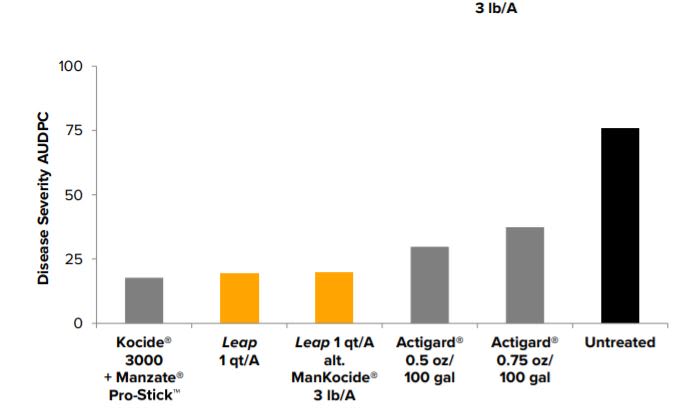Knowde Enhanced TDS
Identification & Functionality
- Agrochemical Functions
- Technologies
- Product Families
Features & Benefits
- Agrochemicals Features
- Disease Control
LEAP contains methyl salicylate (MeSA), a powerful plant extract that elicits a plant’s natural defense systems against pathogen infections. The presence of MeSA can trigger a whole-plant immunity response through a physiological process that helps protect the plant from pathogen spread and further infection. Normally triggered by a localized infection from a pathogen such as bacterial speck or spot, this defense response is started in the absence of the pathogen by treating the plant with LEAP. Due to the unique properties of the MeSA molecule, LEAP’s mode of action includes long-distance signaling to leaves remote from the infection and even to other plants. The signal response results in production and accumulation of pathogenesis-related (PR) proteins that help the plant defend itself against invasion by pathogens. As such, plants should be treated in high pressure periods — before an infection starts — or early on in an infection. LEAP is also a good resistance management tool since it has not demonstrated cross-resistance with any other fungicides/bactericides, making it ideal in rotation or as a tank mix partner with other pathogen control materials. Use of LEAP can reduce pathogen control costs by decreasing or delaying conventional fungicide/bactericide applications.
- Insect Control
The caterpillar insecticidal properties of LEAP are due to the well-known biorational control agent Bacillus thuringiensis subsp. kurstaki (Btk) strain ABTS-351. LEAP contains the same strain of Btk found in DiPel® biological insecticide, the most used Bt insecticide product in the world. Btk strain ABTS-351 produces Bt spores and four different insecticidal proteins (Cry toxins) that form a crystalline matrix in the Bt bacteria. When sprayed on a plant and ingested by susceptible Lepidoptera larvae, these crystals dissolve in the caterpillar stomach, releasing the Cry toxins, which bind to insect-specific receptors in the gut walls. The toxin proteins break down midgut cell walls, invading the pest with Bt spores and causing a massive physiological imbalance which results in localized cell death. Minutes after consuming LEAP, insects stop feeding and ultimately die. LEAP’s fast-acting (insecticide) mode of action in turn helps lessen disease incidence by reducing leaf damage from caterpillar feeding, thereby limiting potential entry points for disease pathogens to enter the plant.
Applications & Uses
- Markets
- Applications
- Applicable Crop
- Insecticide Target Species
- How To Use
Rate 0.5–2 qt/A (1 qt for typical use) Timing Apply before the disease appears. Reapply every 5–10 days during the season up to 8 applications. Method Ground application Spray Volume Apply in sufficient water to provide thorough leaf coverage Adjuvant Refer to the label before deciding to add an adjuvant PHI / REI 0-day preharvest interval / 12-hour reentry interval
Technical Details & Test Data
- Two-Way Protection from Bacterial Spot and Worms
Leap® ES Bacterial Disease Management Biological Insecticide Emulsifiable Suspension is the only alternative to copper-based products that, as part of a program, delivers two-way protection of both bacterial disease and the Lepidoptera larvae (worms). Triggers defenses in the plant to minimize effects from bacterial diseases Proven and effective worm control—active toxins control Lepidoptera larvae New and reliable mode of action for bacterial disease management reduces the need for copper-based products Newest active for growers looking to improve the resistance management programs for bacterial diseases
Tomato Bacterial Spot Management Program
- Leap and Actigard® stand-alone treatments were applied weekly
- Leap alt. ManKocide® treatment—Leap was applied every week for 2 weeks, then ManKocide® was applied the 3rd week in rotation
- AUDPC (Area Under the Disease Progress Curve)
Bell Pepper Bacterial Spot Management Program
- Stand-alone treatments were applied weekly
- Leap alt. ManKocide® treatment— Leap or ManKocide® were applied on alternating weeks in a rotation
- AUDPC (Area Under the Disease Progress Curve)



